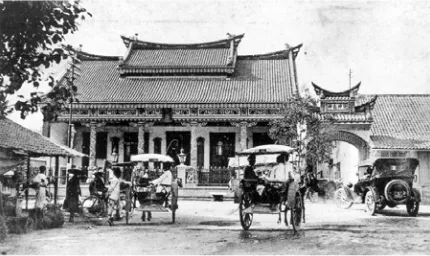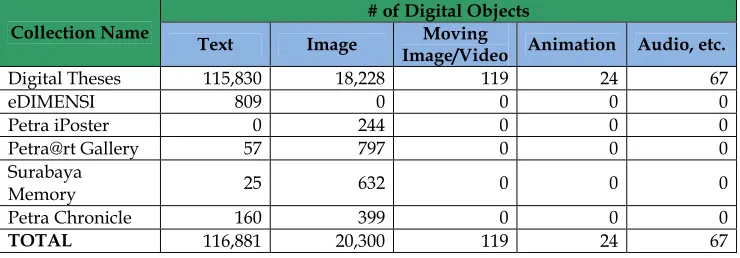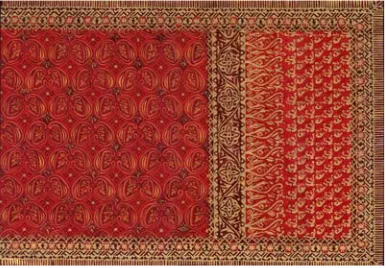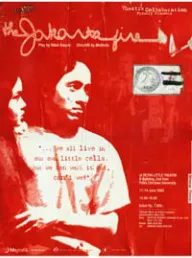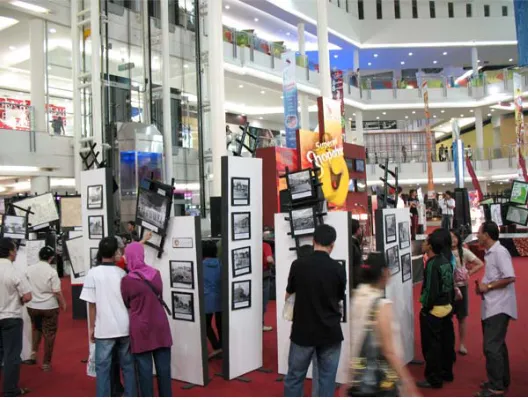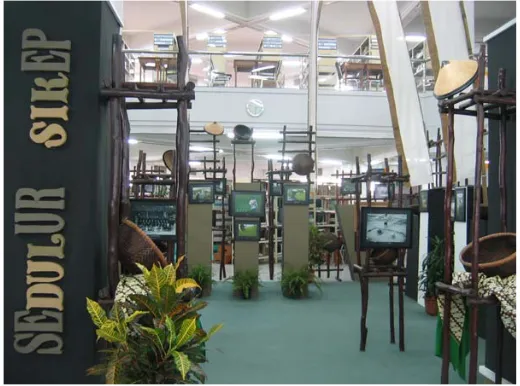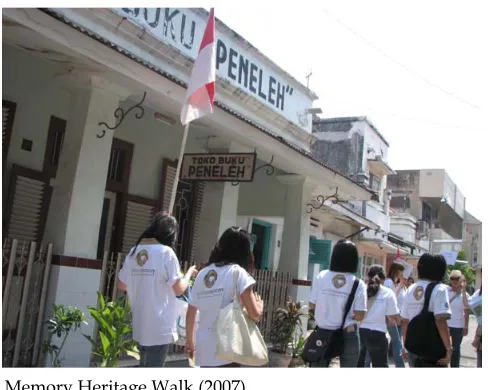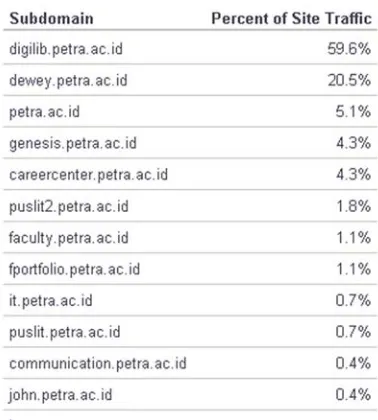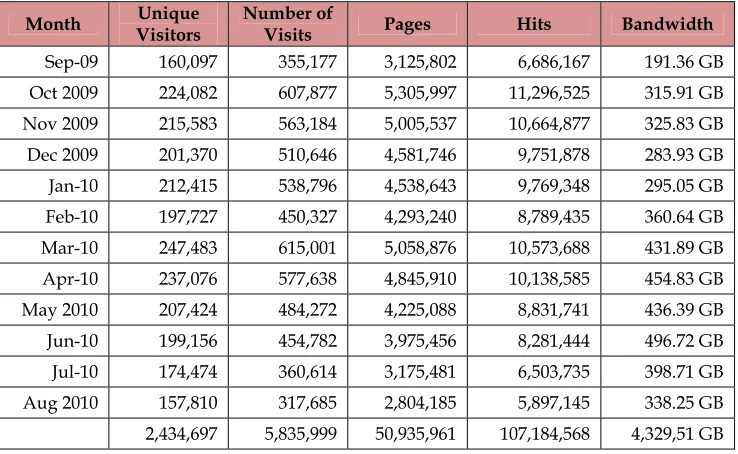Institutional Repositories: Facilitating Structure,
Collaborations, Scholarly Communications,
and Institutional Visibility
Liauw Toong Tjiek (Aditya Nugraha)
Petra Christian University
Indonesia
1. Introduction
The advancement of information and communication technology (ICT) – Internet in particular – has caused enormous changes in the world we are living today. Many things are not what they used to be decades, or even years ago. Imagine how we communicated and shared information in the fifties, when computers were still ‘archaic’ and the Internet was still in its inception stage. Compare that to the numerous communication gadgets and the information overload that we have today. All those changes happened in only a little over fifty years.
Libraries as information providers have also undergone massive changes due to their close association to the way people communicate, collect, manage, use, and share information. Any advancement in ICT will have direct and indirect impacts on the ways libraries provide their collections and services to their user communities and society in general. Some advancements might be welcome by libraries. Others might be perceived as threats to the existence of (traditional) libraries since they are perceived as ‘things’ that would cause (traditional) libraries to become obsolete, or at least redundant, amidst the new emerging technologies. Some have also caused mixed reactions among librarians, who might ‘love’ and ‘hate’ them at the same time. Librarians usually love advancements in ICT since they can help tremendously in the librarians’ efforts to fulfill the information needs of their users. However librarians might also notice that many (or most?) of their traditional roles as librarians have been, or will be, taken away from them by those advancements.
Digital libraries (DLs), which include all of its variants such as institutional repositories (IRs), is one of the most important changes in libraries triggered by advancements in ICT. DLs have caused fundamental changes in the way libraries operate. It has also challenged the traditional roles of libraries and compelled them to redefine their roles in this new environment. It is in this context that discussions in this chapter will proceed.
fact, it is still far from an ideal implementation of IRs. It is being used solely for the purpose of sharing experiences gained from its execution. Naturally, perspectives raised in the discussion will be of an academic librarian in a developing country. The environment, where the project is being carried out – a medium-sized private university with mostly undergraduate students – will certainly offers certain influences into the discussions as well.
2. ICT Advancements and the future of libraries
The rapid developments of ICT since the birth of computers and the Internet has contributed so much in changing the way we live our daily life. They affect the way we do things, which includes the way we do our jobs. They even affect the way we relate to one another in terms of personal relationships, as well as professional ones. Almost everything we do in daily basis has something to do with ICT. It ranges from simple stand-alone applications to collaborative and networked systems. Nowadays it’s almost unimaginable to write an article without the help of a word processor application, online dictionary or thesaurus, reference management application, and online journal databases. All these advancements have offered invaluable help for people from any professions in terms of working more effectively and productively.
Some ICT advancements however can cause fundamental changes in the traditional roles and functions of certain professions. They fundamentally alter the ways in which people or institutions provide products and services. Libraries – especially academic libraries – and their librarians have been living through these inevitable, yet often subtle, transformations. Nowadays most librarians are familiar with – or at least aware of – approval plans, selector services, new acquisitions of library materials with embedded electronic bibliographic records, copy cataloging, self-check-in/out, Internet search engines, virtual reference services, etc. All these roles and/or functions (acquisition, cataloging, reference, etc.) were traditionally the domains of (local) librarians. Local librarians used to have the authority over or in charge of performing these roles and/or functions. However the new environment affected or created by ICT advancements has created new ‘arrangements’, where these basic roles and/or functions are gradually being taken over by ICT, or at least transferred to other institutions outside the libraries (Liauw, 2006b). In short, traditional roles and/or functions of librarians are being challenged by the rapid technological changes, which usually also leads to social changes.
Librarians need to ‘redefine’ their roles and/or functions in the new landscape of the future information society. Davenport stated something that I believe is a good response to the challenge. She suggested that librarians should have “expanded, more collaborative roles in the creation and dissemination of knowledge,” which will empower (academic) libraries to assume new role and/or function as learning space instead of information storehouse (Davenport, 2006). It is now up to librarians on how to assume this ‘new’ role and/or function in the new landscape.
3. Institutional repositories and desa informasi
IRs is one of the relatively new terms generated by advancements in ICT, one that needs to be defined to enable us to proceed with our discussion. One of the pioneers in IRs – Clifford Lynch – gave one of the most fundamental definitions of IRs:
"a university-based institutional repository is a set of services that a university offers to the members of its community for the management and dissemination of digital materials created by the institution and its community members. It is most essentially an organizational commitment to the stewardship of these digital materials, including long-term preservation where appropriate, as well as organization and access or distribution." (Lynch, 2003)
It is worth to mention specifically that Lynch defined IRs as “a set of services” instead of merely digital contents. Lynch also sees “institutional repositories as a species of digital library than a publishing platform,” (Poynder, 2006) which is a sufficient ground for me to conclude that “the terms IRs and DLs … [are] interchangeable” (Liauw, 2006a). Lynch’s definition – “a set of services” – suggests his far reaching look into the future. However for the sake of flow of discussion, let’s talk first about (digital) contents of IRs.
There are several different views on what IRs should contain. These different views don’t necessarily contradict one another. They rather define IRs contents from different scopes and perspectives, which in my opinion can complement one another. McDowell gave a more technical classification of IRs contents by stating:
“IR contents were classified into the following types: ETDs; e-prints (pre- or post- print articles); working papers and technical reports; conference proceedings and presentations; e-journals and e-books; learning objects; multimedia files (digital audio/video); datasets; pictures (images); digitized archival documents and university records (historical texts and primary sources); non-scholarly institutional publications; undergraduate student work; graduate student work (non-ETD); and course content (syllabi, assignments, lectures).” (McDowell, 2007)
Crow defined IRs contents more concisely as “scholarly; produced, submitted, or sponsored by an institution’s faculty (and, optionally, students), or other authorized agents; non-ephemeral; and licensable in perpetuity” (Crow, 2002a). In terms of contents of IRs, Lynch suggested that:
“a mature and fully realized institutional repository will contain the intellectual works of faculty and students – both research and teaching materials – and also documentation of the activities of the institution itself in the form of records of events and performance and of the ongoing intellectual life of the institution.” (Lynch, 2003)
It is interesting to notice that Lynch’s definition above doesn’t limit IRs contents to “the intellectual works of faculty and students – both research and teaching materials” (emphasis added) only. Instead it also encompasses “documentation of the activities of the institution itself in the form of records of events and performance and of the ongoing intellectual life of the institution” (emphasis added).
librarians in defining both characteristics, and it will be used in this chapter to refer to contents with both characteristics.
DI started off as a limited-in-scope of theses digitization project to address the physical space limitation of PCU Library, which then evolved into an institutional repositories project. DI utilizes a custom-made web-based application called iSPEKTRA to manage digital objects using modified Dublin Core metadata set (http://dewey.petra.ac.id/dgt_directory.php). Although “interoperability on a metadata level has clearly been the most active area in digital repositories … [and] spurred by the Open Access movement, numerous repositories exposed their metadata through standard protocols,” (Aschenbrenner et al., 2008) iSPEKTRA has not yet addressed the interoperability issues in terms of compliance to Open Archives Initiatives – Protocol for Metadata Harvesting (OAI-PMH). It is a crucial issue that is being addressed along with the development of the new version of iSPEKTRA.
DI divides its collections into Themes instead of one big collection in order to create ‘added value’ to the collections. The main consideration is that “having several smaller thematic collections of interest to the communities is far better than having one big collection consisting of just about anything people can throw into the collection without any defining ‘character’ that binds them together” (Liauw, 2006a). The current DI collections are as follows: (Liauw, 2005)
• Digital Theses: Petra Christian University students’ theses collection in digital format; mostly PDF documents. There are also an increasing number of multimedia resources generated by the students of Faculty of Art and Design.
• eDIMENSI: digital version of articles from DIMENSI, scientific journals published by various academic departments of Petra Christian University.
• Petra@rt Gallery: works of art by campus communities (mostly students’ works) or works of art that are exhibited/displayed at Petra Christian University campus; mostly photographs and digitized-images. The collection contains wonderful visual resources, capturing and immortalizing the intrinsic knowledge and values of art in the works documented. Some of the wonderful themes are the Visual Poetry, Café Décor, Chairs of Indonesia, Destination Branded, Nusantara Bersatu (United Archipelago), etc.
• Petra iPoster: posters (with visual design elements) of events or issues related to Petra Christian University.
• Petra Chronicle: historical documents related to Petra Christian University.
The collection themes above clearly represent the “locally-produced” definition of DI contents. One other collection that represents the definition of “features of local entities” is the Surabaya Memory collection. It contains digital heritage resources on Surabaya city. Another newly-planned collection will be the “Chinese in Indonesia” digital collection, which is intended to supplement the special collection of the same name (in physical/ hardcopy format). This latest collection (still in planning stage as of the time of this book’s publication) is created as support system for the newly-established Center for Chinese Indonesian Studies at Petra Christian Universities.
4. Facilitating structure amidst information overload and chaos
As with most IRs, “student work accounts for the largest percentage of items” in DI. Digital Theses is the largest collection in DI so far. This phenomenon happens in many institutions implementing IRs since “ETDs [Electronic Theses and Dissertations] are simply the lowest hanging fruit, and new submission batches can generally be counted on each semester” (McDowell, 2007). ETDs are also the ‘preferred’ contents since they “raise the profiles of the students who author them, the faculty and departments who foster them, and the institutions that provide them to the world” (Lippincott, 2006). The following tables will give readers a glimpse of DI collections.
Collection Name/Theme # of Records # of Digital Objects Total Size (bytes)
Digital Theses 12,618 134,268 170,284,316,475
eDIMENSI 809 809 282,689,311
Petra iPoster 120 244 365.416.831 Petra@rt Gallery 261 854 4,132,526,401 Surabaya Memory 258 657 402,415,694 Petra Chronicle 180 559 2,489,567,862
TOTAL 14,246 137,391 177,956,932,574
Table 1. Breakdown of Desa Informasi’s Digital Collections by Themes (as of Aug 31, 2010). Source: Petra Christian University Library – 2009/2010 Annual Report
# of Digital Objects Collection Name
Text Image Moving
Image/Video Animation Audio, etc.
Digital Theses 115,830 18,228 119 24 67
eDIMENSI 809 0 0 0 0
Petra iPoster 0 244 0 0 0
Petra@rt Gallery 57 797 0 0 0
Surabaya
Memory 25 632 0 0 0
Petra Chronicle 160 399 0 0 0
TOTAL 116,881 20,300 119 24 67
In their article titled “Size isn’t everything: Sustainable repositories as evidenced by sustainable deposit profiles,” Carr & Brody stipulated that “sustained deposits” is a more accurate measurement than merely the size of IRs, since it reflects “community engagement.” They stated that “one of the measures of repository success should therefore be the university community's take-up of these services” (Carr & Brody, 2007). They warned against using the size of IRs as the only indication of ‘healthy’ IRs. Referring to Davis and Connolly’s 2007 article titled Institutional repositories: Evaluating the reasons for non-use of Cornell University's installation of DSpace, they noticed that “a repository can exhibit respectable overall growth that is attributable mainly to special-case batch imports” (Carr & Brody, 2007). Along this line of thinking, we should then analyze the deposit profile of DI to see any indication of its ‘health.’ Table 3 shows the growth of digital resources in DI from 2005 up to 2010. Carr & Brody used daily deposit profile in their survey of IRs by utilizing ROAR registry of Institutional Repositories. However since such data is not available for DI, Table 3 uses annual deposit profile instead.
2005/2006 2006/2007 2007/2008 2008/2009 2009/2010
# of Records 3,178 5,025 7,697 10,857 14,246
Growth from Previous
Year N/A 1,847 2,672 3,160 3,389
# of Digital Objects N/A 39,438 68,510 98,092 137,391
Growth from Previous
Year N/A N/A 29,072 29,582 39,299
Table 3. Growth of Desa Informasi’s Digital Collections (2005 – 2010).
Source: Petra Christian University Library – 2005/2006 to 2009/2010 Annual Reports We can conclude from Table 3 that DI has a ‘healthy’ deposit profile since the growth of its contents is sustainable. Table 3 shows a steady growth in # of Records and Digital Objects every year. It is an indication of community engagement in supplying resources for DI. We can also conclude from our discussion so far that higher education institutions produced intellectual works in numerous subjects and formats besides the obvious scholarly works (theses and dissertations, journal articles, and research reports). Student works usually comprise the bulk of the works.
Unfortunately most lecturers and academic departments don’t have the ‘sensitivity’ or the expertise needed to identify these student works as intellectual outputs that can be re-used as learning resources. They don’t know how to collect, organize, manage, and re-use/serve these digital objects as learning resources. Davenport observed that “[academic departments in universities] lack the organization and structures that would allow campus departments to easily share such information” (Davenport, 2006). Based on my observations, most faculties only keep the digital version of the resources on CD Roms and stack them in cabinets. This practice will consequently make the resources hard to be found and re-used. It’s as if faculties are lost amidst the chaotic and unstructured information overload.
content management systems) and data sharing platforms (e.g. for the re-use of research data and learning objects)” (Poynder, 2006). This is one of the variations of IRs implementations (Furlough, 2010) and a common approach in Indonesian higher education libraries. However libraries should not just offer the IRs platform as a solution and then leave the academic departments, faculties, and students on their own to figure out how to self-archive (uploading their works into the IRs) and help them organize those resources. Based on an article by Erickson, Rutherford, & Elliott (2008), Salo warned against this approach when she reminded the readers that “the term ‘self-archiving’ has been taken too literal, abandoning faculty to their uncertainties and incapacities” (Salo, 2008).
Librarians should actively assume their ‘new’ role as IRs managers to increase the probability of a successful implementation of IRs by providing needed assistance to students and (especially) faculties in populating IRs. Libraries should do extra efforts to assist the academic departments, faculties, and students to get their works into IRs. However in their efforts to populate IRs, it is of a strategic importance for libraries to always present the issue as the academic departments and lecturers’ interests, not merely the libraries’ (Liauw, 2006a).
Mediated-deposit services was the method of choice for content acquisition for DI since it was formally launched in 2005. Local conditions required it and the fact that librarians would be the ones in charge of managing the contents – including the metadata – sounded more promising in the long run. The approach also asserts the role of librarians in providing some sense of structure into the whole collections. This choice turns out to be the right one since it works so far, while the alternative doesn’t look too promising. In her article Salo stated that “the notion that faculty members [(and students for that matter)] will actually push buttons and type metadata in order to deposit materials into IRs is an article of faith
among repository-software developers. In practice, however, most deposits are third-party mediated, many by librarians, some by support staff or IT personnel” (Salo, 2008, emphasis added). Salo’s assertions and experience in DI prove that although mediated-deposit services might sound more ‘expensive’ and labor-intensive, it does offer more sustainability for IRs and more visibility to the role of librarians in the overall landscape of university-wide information management/organization.
Fig. 2. Batik pattern in PetraArt Gallery
straight forward since it ‘piggybacks’ on the university-wide theses deposit policy, which mandates all graduating students to deposit their theses to the Library in hardcopy and softcopy format. Contents for Petra@rt Gallery on the other hand are much harder to acquire since they are produced sporadically without any fixed-patterns. However it is crucial that content acquisition process establishes some kind of connections to the “administrative systems of the university or the local communities it serves” as Liauw suggested, since “otherwise the collection [(acquisition)] process will be too massive to manage sporadically and the sustainability of the flow of resources from the communities into the IRs will depend largely on fluctuating individual interests” (Liauw, 2006a). Contents for eDIMENSI are acquired through formal cooperation with the university’s research center, which acts as the publisher for DIMENSI journals. This approach ensures 100% incorporation of all articles published by the center into DI. Petra iPoster provides valuable lessons in its content acquisition effort and deserves a longer description. It is a common practice in Indonesian universities for the Public Relations office to be in charge for approving posters that will be posted on campus premises. We would have thought that a formal cooperation with the Public Relations office would guarantee 100% acquisition of posters at PCU by requiring poster-issuing units to provide the digital version of the submitted posters. However experience showed that it isn’t as simple as that initial assumption. User behaviors play critical roles in this matter. Poster-issuing units usually don’t have the digital version since they outsource the design and printing process to outside vendors. It requires extra time and effort to get them from the vendors. Other reasons might simply be the reluctance of the poster-issuing unit to spend more time preparing the digital copy to be submitted to the Public Relations office, especially when people are usually under a tight deadline to put the posters up. A request to provide an extra hardcopy poster as an alternative, instead of the digital version, was not successful either. We then noticed that another unit – the Campus Facility Management unit – is in charge for taking down ‘expired’ posters all across campus based on the expiry date stamped on each poster by the Public Relations office. We saw it as an opportunity to collect the posters for inclusion into Petra iPoster. So, instead of discarding the posters we merely ask the Campus Facility Management unit to send the posters to the Library. This never-thought-of-before approach proves to work well since it does not require any – or at least too much – disruption in the unit’s daily operations. Aschenbrenner et al. suggested this approach by saying that “repositories [should] become a natural part of the user's daily work environment” (Aschenbrenner et al., 2008). The authors
were referring to the overall aspects of IRs but the principal can be applied in a narrower scope to content acquisitions in IRs. We don’t encounter too many difficulties in acquiring contents for Petra Chronicle since most historical materials related to PCU will be deposited to the Library. The Library has had supports from various parties in developing Petra Chronicle and Petra iPoster since the personal nature of the resources, which have certain appeals to the nostalgic aspects of various stakeholders. The support only increases with the upcoming 50th Anniversary of PCU in 2011.
Fig. 4. Surabaya Memory Exhibition in A Mall (2007)
In acquiring contents for IRs, librarians should actively come to the academic departments, lecturers, and students as someone who is offering an information/resources management system to address their needs for organizing faculty and student works. IRs can be offered as the solution that will help in introducing and facilitating structure amidst the bulk and numerous different types of faculty and (especially) student works. Librarians will then be able to re-assert their role as information managers for their campus communities.
money spent in acquiring those resources has become a big obstacle to share the resources – not even their digitized version – with the society. It’s also a common knowledge that “big collectors tend to collect for their own enjoyment” (Liauw, 2010, emphasis added). Facing such challenges, Liauw suggested two strategies to help alleviate the problem. The first strategy is to collaborate with big collectors to hold exhibitions. When we have gained their trust it usually (but not always) is easier to solicit their participations by contributing some of their collections to SM. The second strategy is to “network with other heritage-based organizations to identify individuals with possession of cultural heritage materials” (Liauw, 2010). I would like to also add that it is very important to show to stakeholders (especially those big collectors) that the shared resources will benefit the society.
Although content acquisition itself has posed many challenges, it is essential that we do not view any IRs projects only as a matter of populating it with the desired contents. McDowell offered another perspective on IRs. He offered a definition from functional point of view, which defines IRs as: (McDowell, 2007)
1. “an institution-wide service. Faculty members of every academic unit must be able to submit, regardless of departmental affiliation [no use or subject limitations].
2. intended to collect, preserve, and provide access to, among other things, faculty scholarly output in multiple formats.
3. must be actively taking submissions.”
Although DI does fulfill the above definition and has managed to reach some level of sustainability in content acquisition, it still falls short in providing services and interactions/ collaborations to its users, capitalizing on the acquired contents. Regarding future directions for IRs, Furlough suggested that IRs (contents) should be “integrated into instruction, reference and collection development” (Furlough, 2010).
Based on the discussions above IRs, such as DI, has managed to fulfill its role to “serve as tangible indicators of a university's quality and to demonstrate the scientific, societal, and economic relevance of its research activities.” Let’s now examine the successfulness of IRs in fulfilling its other role to “provide a critical component in reforming the system of scholarly communication … [and to] reasserts control over scholarship by the academy, increases competition and reduces the monopoly power of journals” (Crow, 2002b).
5. Facilitating scholarly communications
IRs] may threaten their rights over their work, their relationship with their favorite publishers, or their status in their disciplinary communities.” This trend has led Salo to assert that “libraries whose support for repositories rests purely on hopes of collecting peer-reviewed literature would be well-advised not to bother with them” (Salo, 2008).
Another challenge in the scholarly communication arena comes from the fact that most IRs are functioning only as digital resources management system, without “the more complex services on which users [authors or faculties] depend” (Chavez, et al., 2007). IRs might be useful and/or powerful for organizing and managing digital resources, but “[authors] want something that will support the authoring process, not just the finished product” (Foster, 2004). IRs also needs to strive to “become a natural part of the user's [or authors’] daily work environment” (Aschenbrenner et al., 2008). This might explain why IRs can achieve relative successes in acquiring contents from students, but not from faculties or peer-reviewed publication authors. Salo noticed that slight exceptions might apply for “younger scholars [or faculties, who] may [still] be attracted to self-archiving as a way to game a prestige system otherwise stacked against them” (Salo, 2008).
Besides all the shortcomings of IRs in the scholarly communication arena, I believe IRs has managed to reduce the total monopoly of conventional journal publishers. Many journal publishers have revised their publishing and copyright policies to allow authors to self-archive in institutional or subject repositories. The new policies wouldn’t have had materialized had it not been because of open access movement (or spirit) embodied in IRs. There are currently open access (book and journal) publishers offering alternatives to conventional publishers. More and more universities and research institutions are jumping into the open access (and IRs) bandwagon by instituting Open Access Mandates in their institutions. Although in its current state IRs might not achieve big success in (radically) reforming scholarly communication, I believe that IRs has contributed – to certain extent – the efforts in “advancing the positive transformation of scholarly communication over the long term” (Crow, 2002b, emphasis added).
The same challenge is faced by DI in acquiring journal articles from faculties. DI – as an IRs system – has not yet accommodated any authoring or collaborative process. In its current state, DI acquires contents for eDIMENSI (scientific journal articles) collections through a formal cooperation with the Research Center at PCU. The Research Center is the formal agency at PCU that manages the review, editorial, and publication processes of DIMENSI journals using the Open Journal System (OJS). The cooperation allows the Library to batch download the newly published articles and feed them into DI. It might be the future direction to merge the two systems into a single platform, which will streamline much of the processes involved in both entities (Research Center and Library) and open up opportunities to create new collaborative features in the future.
6. Facilitating collaborations
An important aspect of IRs that is often overlooked is its potential as a collaborative platform for the campus communities. If we agree that IRs is, as Lynch stated, "a set of services that a university [library] offers to the members of its community for the management and dissemination of digital materials created by the institution and its
academic libraries that implement and manage IRs will soon discover themselves introduced to a rich variety of local contents produced by different campus communities covering a wide range of academic disciplines.
Fig. 5. A Thematic Onsite Exhibition Featuring Photography Documentary of Sedulur Sikep Ethnic Group in Central Java, Indonesia (2006)
Cross-pollination or cross-fertilization of knowledge is a natural consequence of exposures to such rich and diverse local contents. Contents produced by a campus community can be re-used as learning resources by other campus communities. Marketing or promotional efforts can be conducted by academic libraries to introduce these local contents to all academic departments and provide insights on possibilities of their uses for each department. Libraries can also expand features in their IRs to be able to link to e-learning systems (such as Moodle) used on campus. The linking will enable students and faculties to access our local contents directly from the e-learning systems that they are using for teaching and learning, thus increasing exposures of the contents to various campus communities. These efforts will expose local contents from a specific campus community to a wider audience.
example shows that academic libraries should treat their local contents and exhibition spaces as assets to be used to facilitate collaborations and conversations across academic disciplines.
Fig. 6. School Children Playing Information Scavenger Game at Surabaya Memory Exhibition (2007)
Fig. 7. Surabaya Memory Heritage Walk (2007)
by Architecture Department, Tourism and Leisure Management Department, and Hotel Management Department. However SM has also become a collaborative platform for PCU Library and other campus units to reach out to the society in Surabaya city. Every May (anniversary of Surabaya) SM conducts thematic exhibitions in a mall in Surabaya. During the exhibition, which usually lasts four to ten days, various competitions, cultural performances, and heritage walks are held to celebrate the city’s anniversary. All these programs and activities have been made possible by the collaborations between the Library and various academic departments. The Event Management course at Hotel Management Department has been using SM as real world projects for its students. The students are assigned to help the Library in preparing and supervising the exhibition, looking for sponsors, creating events and performances during the exhibition, etc. The Cultural Tourism course at Tourism and Leisure Management Department has also been using SM as real world projects for its students by conducting heritage walks throughout the year for campus communities as well as the general public. IRs can also serve as collaborative platform to build networks with various parties outside the university boundaries. SM has been functioning as a networking tool for PCU. Various co-operations and collaborations have been initiated between PCU communities and outside parties through SM. Furthermore SM has served as a common platform for campus communities at PCU to reach out to the society.
It is obvious from the discussions above that IRs can facilitate collaborations if academic libraries are willing to go beyond merely populating their IRs with digital contents. Collaborations with various campus communities will strengthen the libraries’ roles on campus and help libraries tremendously in advocating their services to the campus communities. Libraries can even increase the institutional visibility of the whole institution with their IRs projects.
7. Facilitating institutional visibility
Table 4. Domain Profile for “petra.ac.id” from Alexa Source: http://www.alexa.com/siteinfo/petra.ac.id
http://dewey.petra.ac.id (the online catalog of PCU Library that store the metadata of the digital resources stored in DI) are the two top sub-domains that generate 80.1% of the traffic to “petra.ac.id” domain. (years) age range and mostly browse the Internet from school or home. This is a very significant contribution that PCU Library – through DI – has made to the overall ‘Internet marketing’ of the university. The access statistics from Alexa is confirmed by the weblog of the DI server (http://digilib.petra.ac.id) as shown in Table 5. More opportunities to facilitate institutional visibility can be gained when we share metadata of our digital contents with other IRs. This can be achieved by utilizing the OAI-PMH or even a ‘low-tech’ approach by exporting the metadata and exchange them using spreadsheet application such as Microsoft Excel. This approach is being utilized by DI while an upgrade to an OAI-PMH compliant system is still in progress. The Indonesian Ministry of National Education under its Directorate General of Higher Education has launched a collaborative program to create a ‘union catalog’ of metadata for local contents from higher education institutions across Indonesia called Garuda (http://garuda.dikti.go.id). Networking opportunities like this provide increased visibility of our IRs and host institution.
Month Unique Visitors
Number of
Visits Pages Hits Bandwidth
Sep-09 160,097 355,177 3,125,802 6,686,167 191.36 GB Oct 2009 224,082 607,877 5,305,997 11,296,525 315.91 GB Nov 2009 215,583 563,184 5,005,537 10,664,877 325.83 GB Dec 2009 201,370 510,646 4,581,746 9,751,878 283.93 GB Jan-10 212,415 538,796 4,538,643 9,769,348 295.05 GB Feb-10 197,727 450,327 4,293,240 8,789,435 360.64 GB Mar-10 247,483 615,001 5,058,876 10,573,688 431.89 GB Apr-10 237,076 577,638 4,845,910 10,138,585 454.83 GB May 2010 207,424 484,272 4,225,088 8,831,741 436.39 GB Jun-10 199,156 454,782 3,975,456 8,281,444 496.72 GB Jul-10 174,474 360,614 3,175,481 6,503,735 398.71 GB Aug 2010 157,810 317,685 2,804,185 5,897,145 338.25 GB 2,434,697 5,835,999 50,935,961 107,184,568 4,329,51 GB Table 5. Web Access Statistics of Desa Informasi (Sep 2009 – Aug 2010)
Source: http://digilib.petra.ac.id/awstats/awstats.pl
Webometrics rankings are important for us in Indonesia since they are being used by Directorate General of Higher Education as one of several metrics to measure performances of Indonesian higher education institutions. PCU has been ranked #5 along with big state universities in Indonesia. A good rank will surely contribute to the increased visibility of the host institutions. This fact strengthens the assertion that IRs serve as one of “meaningful indicators of an institution’s academic quality … thus increasing the institution’s visibility, status, and public value” (Crow, 2002b).
8. Conclusion
Advancement in ICT has reshaped the landscape of the future for many professions. Librarian as a profession and libraries as institutions are not immune to changes brought by ICT. Many of their traditional functions and/or roles have been altered or even taken away from them by technology, thus librarians and libraries –especially academic libraries – need to ‘redefine’ their functions and/or roles to stay relevant in the new landscape of the future. Institutional repositories (IRs) – as a species of digital libraries (DLs) – provides opportunities for academic libraries to re-assert their roles in the communities they serve. Through IRs academic libraries can strengthen their roles as managers of institutional information assets and re-use them as learning resources for the benefits of the campus communities.
doing all these efforts libraries introduce structure into the myriads of digital contents available in or produced by campus communities.
Although in the scholarly communications arena IRs has not yet achieved substantial successes, IRs has managed to at least reduce the total domination of conventional journal publishers. With extra efforts libraries can utilize IRs to facilitate scholarly ‘conversations’ across different academic disciplines on campus.
By setting goals beyond merely populating IRs, libraries will be able to capitalize on IRs’ contents to create various programs and activities that will facilitate and foster collaborations among different campus communities, and between campus communities and the society. IRs can even develop into a common platform for campus communities to reach out to the society.
Amidst the ups and downs of IRs projects in academic libraries across the globe I would like to echo the optimism voiced by Aschenbrenner et al.:
“Digital repositories have rapidly become an integral part of higher education and other digital environments. Setbacks with regard to user adoption, and technological dead ends of insular efforts, have not induced a significant dip in the growth of the community. Instead, they have added new perspectives on how repositories can be embedded into their organizational and social contexts.” (Aschenbrenner et al., 2008)
More fundamentally, amidst technological changes and the changing landscape of our profession, I would like to close our discussion by citing one of the fundamental principles of our profession:
Underlying the special character of librarianship is not its techniques, but its fundamental values. The significance of librarianship lies not in mastery of sources, organizational skills, or technological competence, but in why librarians perform the functions they do. (Rubin, 2004, p. 468)
9. References
Aschenbrenner, Andreas et al. (2008). The future of repositories? Patterns for (cross-) repository architectures. D-Lib Magazine, 14 (11/12), November/December 2008. Retrieved September 03, 2010 from
http://www.dlib.org/dlib/november08/aschenbrenner/11aschenbrenner.html Carr, Leslie & Brody, Tim. (2007). Size isn’t everything: Sustainable repositories as
evidenced by sustainable deposit profiles. D-Lib Magazine, 13 (7/8), July/August 2007. Retrieved September 03, 2010 from
http://www.dlib.org/dlib/july07/carr/07carr.html
Chavez, Robert et al. (2007). Services make the repository. Journal of Digital Information, 8(2). Retrieved on September 03, 2010 from
http://journals.tdl.org/jodi/article/view/195/179
Crow, Raym. (2002a). SPARC institutional repository checklist & resource guide. Washington, D.C.: The Scholarly Publishing & Academic Resources Coalition. Retrieved September 03, 2010, from
http://www.arl.org/sparc/bm~doc/IR_Guide_&_Checklist_v1.pdf
Crow, Raym. (2002b) The Case for Institutional Repositories: A SPARC Position Paper. Washington, D.C. The Scholarly Publishing & Academic Resources Coalition. Retrieved September 03, 2010 from
Davenport, Nancy. (2006). Place as Library? EDUCAUSE, January/February 2006. Retrieved September 03, 2010, from http://www.educause.edu/ir/library/pdf/erm0616.pdf Erickson, J., Rutherford, J., & Elliott, D. (2008) The future of the institutional repository:
Making it personal. In Third International Conference on Open Repositories 2008. Retrieved April 10, 2008, from http://pubs.or08.ecs.soton.ac.uk/125/
Foster, Andrea L. (2004). Papers wanted: Online Archives Run by Universities Struggle to Attract Material. Chronicle of Higher Education, 50 (42), pp. A37-A38.
Furlough, Michael. (2010). Sepulchres. Personal blog. Retrieved September 03, 2010, from http://www.personal.psu.edu/mjf25/blogs/on_furlough/2010/05/sepulchres.ht ml
Liauw, Toong Tjiek. (2005).Desa Informasi: Local Content Global Reach. Proceeding of the 2005 Seminar of the International Council on Archives, Section on University and Research Institution Archives. Michigan State University, East Lansing, MI – U.S.A. (Sep 6-9, 2005).
Liauw, Toong Tjiek. (2006a). Desa Informasi – The Role of Digital Libraries in the Preservation and Dissemination of Indigenous Knowledge. International Information and Library Review, 38(3), pp. 123-131.
Liauw, Toong Tjiek. (2006b). Desa Informasi: A virtual village of ‘new’ information resources and services. Program: Electronic Library and Information System, 41 (3), pp. 276-290.
Liauw, Toong Tjiek. (2010).Surabaya Memory: Opportunities and challenges of open access e-heritage repositories. In IFLA Satellite Pre-conference. Mediterranean Agronomic Institute of Chania, Crete - Greece (Aug 6-8, 2010).
Lippincott, Joan K. (2006). Institutional Strategies and Policies for Electronic Theses and Dissertations. EDUCAUSE Center for Applied Research, 2006(13). Retrieved Septermber 03, 2010 from
http://www.educause.edu/ir/library/pdf/ERB0613.pdf.
Lynch, Clifford A. (2003). Institutional Repositories: Essential Infrastructure for Scholarship in the Digital Age. ARL Bimonthly Report, 226. Mar 26, 2004. Retrieved September 03, 2010 from http:// www.arl.org/bm~doc/br226ir.pdf
McDowell, C. (2007). Evaluating institutional repository deployment in American academe since early 2005: Repositories by the numbers, part 2. D-Lib Magazine, 13(9/10). Retrieved September 03, 2010, from
http://www.dlib.org/dlib/september07/mcdowell/09mcdowell.html Poynder, Richard. (2006). Clear Blue Water. September 03, 2010.
http://dialspace.dial.pipex.com/town/parade/df04/BlueWaterMain.pdf
Rubin, Richard E. (2004). Foundations of Library and Information Science (2nd Editiion). New
York: N.Y.
